Heat pumps in cold areas represent a revolutionary heating technology capable of extracting thermal energy from extremely low temperatures. Modern cold-climate heat pump systems can efficiently operate at temperatures as low as -22°F, utilizing advanced inverter-driven compressors and specialized design techniques that overcome traditional performance limitations. These innovative systems provide homeowners with sustainable, high-efficiency heating solutions that dramatically reduce energy consumption and carbon emissions.
What Makes Heat Pumps Effective in Cold Regions?
How Do Cold Climate Heat Pumps Work?
Heat pumps in cold areas leverage sophisticated technological innovations to extract heat from outdoor air, even when temperatures drop significantly. Unlike traditional heating systems, these advanced units use:
- Inverter-driven compressors
- Enhanced refrigerant technologies
- Variable-speed operation
Performance Characteristics
| Temperature Range | Heat Output Efficiency | COP Rating |
|---|---|---|
| Above 32°F | 300-400% | 3.0-4.0 |
| 0°F to 32°F | 200-250% | 1.5-2.0 |
| Below 0°F | 150-200% | 1.3-1.5 |
What Specific Models Excel in Extreme Cold?
Top Cold Climate Heat Pump Models
- Mitsubishi HyperHeat
- Operates at full capacity down to -13°F
- Maximum heat output at -22°F
-
High HSPF2 rating
-
Daikin Aurora
- Efficient performance below 5°F
- Advanced defrost-cycle controls
-
Inverter-driven compressor technology
-
Fujitsu Halcyon
- Maintains heat output in extreme temperatures
- High HSPF ratings
- Reliable cold-weather performance
What Installation Considerations Exist?
Critical Factors for Successful Implementation
Successful heat pump installation in cold areas requires careful evaluation of:
- Home insulation quality
- Square footage
- Local climate characteristics
- Existing heating infrastructure
- Electrical system compatibility
How Much Do Cold Climate Heat Pumps Cost?
Financial Investment Breakdown
- Average Installation Cost: $10,000 – $20,000
- Potential Annual Energy Savings: 30-50% compared to traditional systems
- Estimated Payback Period: 5-10 years
What Maintenance Strategies Ensure Optimal Performance?
Recommended Maintenance Practices
- Regular outdoor unit cleaning
- Annual professional system inspection
- Filter replacement every 3-6 months
- Ensuring unobstructed airflow around external unit
Can Heat Pumps Completely Replace Traditional Heating?
Heating Capacity Analysis
Most modern cold-climate heat pumps can provide:
– 100% heating needs in moderate climates
– 80-90% heating requirements in extreme cold regions
– Supplemental heating might be necessary in sub-zero temperatures
What Future Innovations Are Expected?
Emerging Technologies
- Improved refrigerant compositions
- Enhanced inverter technologies
- AI-driven performance optimization
- More compact and efficient designs
Conclusion

Heat pumps in cold areas represent a transformative heating technology, offering unprecedented efficiency and environmental benefits. Continuous technological advancements promise even more impressive performance in challenging climates.
